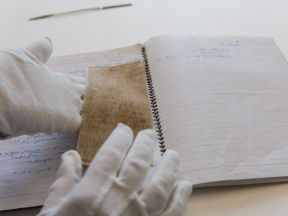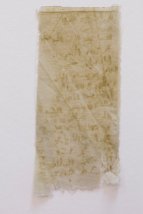Syrian notebook
October 28, 2017 § 7 Comments


(US Holocaust Memorial Museum)
“While languishing inside a grim Syrian prison, a small group of inmates etched the names of 82 prisoners onto scraps of cloth using a chicken bone, rust, and their own blood. They hoped the list would someday make it beyond the walls of the prison, serving as a testament to the atrocities wrought by the Syrian civil war. Thanks to the bravery and ingenuity of one former prisoner, the faded scraps were recently transferred to the United States Holocaust Memorial Museum…The remarkable documents were smuggled out of Syria by Mansour Omari, a 37-year-old human-rights activist. At the start of the war, Omari was working at the Syrian Center for Media and Freedom of Expression, where he was tasked with chronicling the cases of people who had been vanished by the regime of Syrian president Bashar al-Assad. In 2012, the organization’s office was raided and Omari was arrested. According to Avantika Chilkoti of the New York Times, he spent a year in several brutal detention centers, among them the notorious prison supervised by Maher al-Assad, the president’s brother.Although he had been robbed of his freedom and, as Witte reports, subjected to torture, Omari did not stop in his quest to document the horrors taking place in Syria. Aided by four other inmates, he worked to record the names of his fellow prisoners on swatches of fabric that had been cut from the backs of their shirts. They used broken chicken bones as pens, and created “ink” by mixing rust from the bars of their cells with blood from their gums.”
–Smithsonianmag.com
Thank you Kim Trainor for this post, it enveloped me at first in silence and personal examination, but that was followed by determination and solidarity, and also awe in the face of this act of Witness.
One cannot turn away from these accounts, these narratives (these names and the lives inherent in them), must be repeated and incorporated into the collective breath of what we share as cultural workers.
Are we not each other?
In Solidarity,
Beau Beausoleil
beau, yes — I’ve recently tracked down a copy of your Al-Mutanabbi Street Starts Here: Poets and Writers Respond to the March 5th, 2007, Bombing of Baghdad’s “Street of the Booksellers”. I hope to visit your bookstore one day
Dear Kim,
Alas, my bookstore closed last December, but if you ever venture to San Francisco you would be welcome at our kitchen table for a few hours of talking about everything and nothing.
I’m really happy that you found a copy of our anthology. Looking at your work I can see much of what we are doing is squarely in your own vision of how poetry,writing and art can be powerful tools of Witness and Solidarity. Might you be interested in bring part of our project to your campus? I am always looking for academics who really want to engage their students and colleagues with the ideas of our project.
Here are some links to our project!
In Solidarity,
Beau
Smithsonian Exhibit 2016 https://global.si.edu/projects/al-mutanabbi-street-starts-here (Note that this exhibit was part of our 11 venue Washington D.C. area exhibit – After watching the video towards the bottom of the page please click on the link which will take you to another page with more links related to our project. Smithsonian video with Arabic subtitles https://www.youtube.com/watch?v=qjtGTCaA0zg
Arabic Literature (in English) https://arablit.org/2016/11/16/al-mutanabbi-street-2017-as-long-as-we-need-to-remember/
Artists’ Book Project (An Inventory of Al-Mutanabbi Street – Click into a gallery and then onto any book image to see more views of the book and read the artist’s statement.
http://www.bookarts.uwe.ac.uk/al-mutanabbi-street/
Al-Mutanabbi Street Broadsides – http://www.library.fau.edu/depts/spc/jaffecenter/collection/al-mutanabbi/index.php
Absence and Presence – A Printmaking project of Al-Mutanabbi Street Starts Here
https://www.dropbox.com/s/1sq861taoj4m773/Al-Mutanabbi-prints-august-2017.pdf?dl=0
2014 reading at the Arab British Centre in London – https://www.youtube.com/watch?v=kBVmLKd9jIU
Exeter, U.K. A 2016 reading and exhibit for Absence and Presence, part of the Al-Mutanabbi Street Starts Here Project https://www.youtube.com/watch?v=uCjRFCamfPc
Review of our anthology in Jadaliyya, Al-Mutanabbi Street Starts Here http://www.jadaliyya.com/pages/index/12368/al-mutanabbi-street-starts-here
The Center for Contemporary Arab Studies (CCAS) at Georgetown University (Rochelle Davis is the Director). used several of our printmaking project illustrations in their Summer 2017 Newsmagazine (one illustrates the magazine cover). https://ccas.georgetown.edu/publications/newsletters/
Our Bookmark Project – https://markerofwitness.wordpress.com/
A musical piece that was composed for the project https://www.youtube.com/watch?v=R3x8juVd14g
As part of our yearly global readings for al-Mutanabbi Street Starts Here, we helped inspire, with the aid of the poet/activist Amal Al-Jubouri and her Soutuna Project, a series of readings across Iraq as reported on here http://www.iraqicivilsociety.org/archives/8656
hey Beau, I am sorry to hear that! I am teaching a course this upcoming fall & winter on the private life of war — one of the books we read is Leilah Nadir’s Orange Trees of Baghdad, which documents the impact of the invasion & occupation of Iraq on the author’s family, at home & abroad; I will certainly be introducing your project to my students as we also discuss different media and forms of witnessing, such as the Iraq Body Count, poetry by civilians and soldiers, and twitter/periscope feeds. thanks again for all these links, Kim
Dear Kim,
That sounds like a really needed course of study, and thanks for bringing our anthology into the conversation..
I’m wondering if you think that there would be support at your university for bringing there some of the art work produced for our project. We have lately been exhibiting work from our printmaking project, Absence and Presence. This work can be an excellent entry way into meaningful conversations abut free speech, the free exchange of ideas, social justice, censorship, and personal responsibility.
Does this sound like a possibility, and might there be other teachers beside yourself who would see its value? Our project now holds 100 letterpress broadsides, 260 artists’ books, and 210 prints.
Our prints are easy to ship and, depending on exhibit space,usually range from 50-75 prints.
P.S. As an organizer I tend to grasp firmly any extended hand, but if this seems too complicated or overwhelming just tell me.
In Solidarity,
Beau .
hmmm. that sounds quite interesting. I am in fact new faculty at a small college (I still teach marginally as a sessional at UBC but my main faculty position now is at Douglas College). We do have a small art gallery, but I think its mandate is to feature BC artists. I am happy though to send out some feelers to a few colleagues who might know more than me about the possibilities. This might take a little while as it is summer session and a lot quieter just now. Do you have an email where I can reach you? 🙂
Dear Kim,
Many thanks for wanting to explore this further. My email is Beau Beausoleil overlandbooks@earthlink.net
Here is a small poem of mine in the spirit of poet to poet.
Map
I am listening
to your disappearance
I go back into the room
and turn the radio down
I have to cover each sentence as I read it
In Solidarity,
Beau